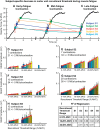The compensatory interaction between motor unit firing behavior and muscle force during fatigue
- PMID: 27385798
- PMCID: PMC5144693
- DOI: 10.1152/jn.00347.2016
The compensatory interaction between motor unit firing behavior and muscle force during fatigue
Abstract
Throughout the literature, different observations of motor unit firing behavior during muscle fatigue have been reported and explained with varieties of conjectures. The disagreement amongst previous studies has resulted, in part, from the limited number of available motor units and from the misleading practice of grouping motor unit data across different subjects, contractions, and force levels. To establish a more clear understanding of motor unit control during fatigue, we investigated the firing behavior of motor units from the vastus lateralis muscle of individual subjects during a fatigue protocol of repeated voluntary constant force isometric contractions. Surface electromyographic decomposition technology provided the firings of 1,890 motor unit firing trains. These data revealed that to sustain the contraction force as the muscle fatigued, the following occurred: 1) motor unit firing rates increased; 2) new motor units were recruited; and 3) motor unit recruitment thresholds decreased. Although the degree of these adaptations was subject specific, the behavior was consistent in all subjects. When we compared our empirical observations with those obtained from simulation, we found that the fatigue-induced changes in motor unit firing behavior can be explained by increasing excitation to the motoneuron pool that compensates for the fatigue-induced decrease in muscle force twitch reported in empirical studies. Yet, the fundamental motor unit control scheme remains invariant throughout the development of fatigue. These findings indicate that the central nervous system regulates motor unit firing behavior by adjusting the operating point of the excitation to the motoneuron pool to sustain the contraction force as the muscle fatigues.
Keywords: firing rates; force twitch; motor units; muscle fatigue; recruitment threshold.
Copyright © 2016 the American Physiological Society.
Figures




References
-
- Adam A, De Luca CJ. Firing rates of motor units in human vastus lateralis muscle during fatiguing isometric contractions. J Appl Physiol 99: 268–280, 2005. - PubMed
-
- Adam A, De Luca CJ. Recruitment order of motor units in human vastus lateralis muscle is maintained during fatiguing contractions. J Neurophysiol 90: 2919–2927, 2003. - PubMed
-
- De Luca CJ, Adam A, Wotiz R, Gilmore LD, Nawab SH. Decomposition of surface EMG signals. J Neurophysiol 96: 1646–1657, 2006. - PubMed
Publication types
MeSH terms
Grants and funding
LinkOut - more resources
Full Text Sources
Other Literature Sources

